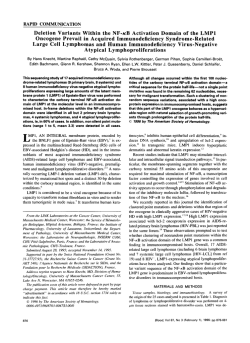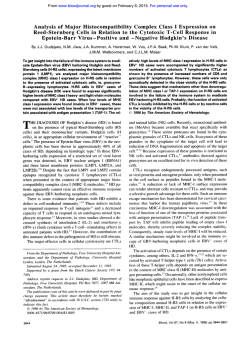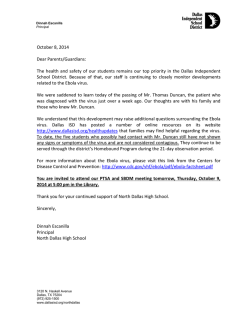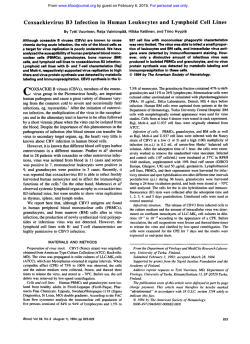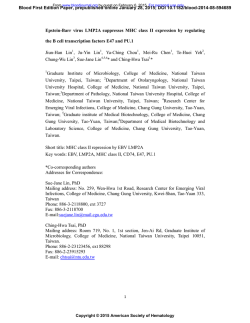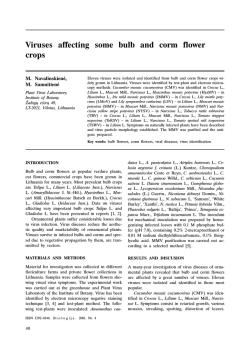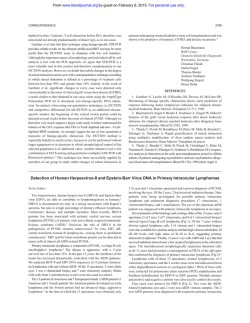
Model of Epstein-Barr Virus Infection of Human Thymocytes
From www.bloodjournal.org by guest on February 6, 2015. For personal use only. Model of Epstein-Barr Virus Infection of Human Thymocytes: Expression of Viral Genome and Impact on Cellular Receptor Expression in the TLymphoblastic Cell Line, HPB-ALL By Robin L. Kaufman Paterson, Colm Kelleher, Thomas D. Amankonah, Joanne E. Streib, Jing Wu Xu, James F. Jones, and Erwin W. Gelfand Infection of B lymphocytes and epithelial tissue by EpsteinBarr virus (EBV) is associated with malignancy and autoimmunity. The cellular receptor for EBV has been identified as CD21 (CR2). A molecule, which is biochemically and immunologically similar t o B-cell CD21, has been identified on a subpopulation of immature thymocytes, suggesting a role for thismolecule in the regulationof T-cell development and further suggesting that immatureT cells might besusceptible t o EBV infection. A growing bodyof literature nowdocuments the presence of EBV in tumors of T-cell origin. We have evaluated the susceptibility of the human immatureT cell line, HPB-ALL, t o infection byEBV. Electron microscopy studies showed a rapid internalization of virusby HPB cells. Southern blotting showed theintracellular presence of lin- ear EBV genomes, and components of the virusreplicative cycle were identified. Expression of the BumHl Z region of the genome, encoding the nuclear protein, ZEBRA, which is strictly associated with productive infection in B cells, was detected in HPB-ALL cells. A spliced variant of 2, RAZ, was also identified. Cell surface expression of EBV late antigens was observed t o occur transiently. Infection of HPB cells was also accompanied by altered expression of T-cell surface molecules involved in antigen recognition, a process critical t o normal development of the T-cell repertoire. Delineation of the outcome of T-cell infection by EBV may lead t o a virus in autoimmune better understanding of the role of this processes and malignancy. 0 1995 by The American Society of Hematology. C number of recent reports now confirm the presence of EBV in tumors and benign proliferations of T-cell and in thymoma of patients with myasthenia g r a ~ i s . ” , ~ ~ In the present study, we have examined the potential for EBV infection of the T-cell line, HPB-ALL, which expresses an immature phenotype characteristic of T cells developing within the thymus. We report that HPB cells are infectable by EBV, which interacts with cell surface CD21 and leads to altered expression of cellular proteins involved in antigen recognition. Components of the virus replicative pathway were expressed in infected HPB cells. These studies suggest that infection of thymocytes in vivo may interrupt the normal pathways of differentiation, thereby contributing to the development of autoimmunity and to T-cell malignancy. D21 (CR2) IS WIDELY expressed on B lymphocytes where it functions as a receptor for complement component C3d,’ CD23’and the pathogen, Epstein-Barr virus (EBV).’.3EBV binds CD21 via the outer envelope glycoprotein, g~350/220.~ The virus enters the cell following endocytosis of the CD2Uvirus complex4 and persists in a latent form in which its genome is circularized.’ Alterations of Bcell function and growth following infection by EBV include malignancy and autoantibody p r o d u c t i ~ n . ~ . ~ , ~ Several recent studies have shown that a molecule identical to or very similar to CD21 is expressed on a population of human T cells and thymocytes.’”’ Additionally, CD21 is highly expressed on approximately 50% of childhood T-cell acute lymphoblastic leukemias (T-ALL),’*-I4many of which express an immature phenotype. The functional role of CD21 on T lymphocytes hasnotbeen studied. Recently, itwas shown that T-cell CD21 could bind C3d.I3 Other studies have shown that soluble CD23 influences the growth of thymocytes,’’ although it was not determined whether this resulted from interaction with CD21, as described for B cells2 Interestingly, a subset of normalhuman thymocytes have been shown to be infectable by EBVI6 (R. K. Paterson, C. Kelleher, J. Streib, T. Amankonah, J. Xu, J. Jones, and E. Gelfand, manuscript submitted). The consequences of EBV infection in these immature T cells is unknown, although a From the Divisions of Basic Sciences and Allergy Immunology, Department of Pediatrics, National Jewish Center for Immunology and Respiratory Medicine, Denver, CO. Submitted February 23, 1994; accepted September 13, 1994. Supported by Grants No. AI-29704 and Pol-AI 29903 from the National Institutes of Health and Otsuka Pharmaceutical Corp. Address reprint requeststo Erwin W. Gelfand,MD, National JewishCenter for Immunology and RespiratoryMedicine,1400 Jackson St, Denver, CO 80206. The publication costsof this article were defrayed in part by page chargepayment. This article must therefore be hereby marked “advertisement” in accordance with I8 U.S.C. section 1734 solely to indicate this fact. 0 1995 by The American Society of Hematology. 0006-4971/95/8502-0016$3.00/0 456 MATERIALS AND METHODS Antibodies and reagents. Phycoerythrin (PE)-conjugated antiCD4, anti-CD3, and anti-CDla monoclonal antibodies (MoAb) and fluoroisothiocyanate (FITC)-conjugated anti-CD8 MoAb were obtained from Coulter (Hialeah, F’L).PE-conjugated anti-CD2 and antiCD5 MoAbs were obtained from Olympus (Lake Success, NY). The anti-CD21 MoAbs, OKB7 (Ortho Diagnostics, Raritan, NJ) and HB5 (ATCC, Rockville, MD), were unconjugated and, for flow cytometry, were detected using, as a secondary reagent, FITC-conjugated goat-antimouse Ig (KPL, Gaithersburg, MD). The anti-CD21 MoAb, B2, was obtained as a PE conjugate (Coulter). FITC-conjugated antiCD23 MoAb was obtained from The Binding Site CO (San Diego, CA). IgGZbcontrol isotype antibody was obtained from Coulter. The gp 350/220 secreting hybridoma was obtained from ATCC. The 125 kD VCA MoAb was obtained from Cambridge Biotech (Rockville, MD) and was detected flow cytometrically after secondary staining with FITC-conjugated goat-antimouse Ig. B95-8 EBV was obtained from Tampa Bay Research (Tampa Bay, FL). The P3HR-1 virus strain, which cannot transform cells due to a deletion in the genome, was prepared as described3’ and titered for its ability to upregulate CD23 on Raji cells. EBV preparations were depleted of virus by treatment with anti-gp350/220 MoAb for 30 minutes at room temperature, followed by incubation with S. aureus, Cowan I strain (SAC) and centrifugation to remove immune complexes. Cellular morphology (HPB cells grew in tight clumps when exposed to active virus) was assessed to monitor removal of virus activity. Flow cytometry. Cells were stained with various MoAb for 30 Blood, Vol 85, No 2 (January 15), 1995: pp 456-464 From www.bloodjournal.org by guest on February 6, 2015. For personal use only. 457 EBVINFECTIONOFT-LYMPHOBLASTOIDCELLS minutes at 4°C in phosphate-buffered saline (PBS) (0.2% bovine serum albumin [BSA]). Unconjugated MoAb were labeled in a second step with FITC-conjugated goat-antimouse Ig. Fluorescence was measured on a Coulter Epics Profile. Electron microscopy. HPB cells were resuspended in cold RPMI-1640 and incubated with B95-8 virus at 4°C for 15 min to allow binding to the cell surface. Virus-bound cells were then cultured at 37°C for varying time periods before fixation. Cells were fixed in 1.5% glutaraldehyde in 0.1 m o m cacodylate buffer pH 7.3 and post-fixed in 1% osmium tetroxide in 0.1 m o m cacodylate buffer. Dehydration was proceeded through a graded series of acetone and infiltration into Luft’s 3:7 embedding resin. Uranyl acetate and Reynold’s lead-stained sections were evaluated and photographed using a Philips 400T electron microscope at an accelerating voltage of 60 kv. B95-8 cells, which are productively infected with virus, were fixed directly. Cell culture. HPB-ALL cells were originally derived from a child with T-ALL.” The Burkitt’s lymphoma B-cell lines, Ramos (EBV-negative) and Raji (latent EBV’), were obtained from ATCC. Cells were maintained at 106/mL in “1-1640 (GIBCO, Grand Island, NY) supplemented with 10% fetal calf serum (FCS), Lglutamine (2 mmol/L), penicillin (100 U/mL) and streptomycin (100 pg/mL), in an atmosphere of 5% C02 at 37°C. EBV was added at a final concentration of lo6 transforming units/mL for varying time periods. In some experiments, cells were pretreated with the antiCD21 MoAb, OKB7 (5 or 10 pg/mL), which blocks the EBV binding site on the receptor, for 20 minutes at 37°C before EBV addition. As a control for the effects of OKB7, an irrelevant IgG2,, MoAb was examined in parallel and did not influence CDla or viral capsid antigen (VCA) expression. Detection of RA2 and BZLF-I mRNA transcripts by polymerase chain reaction. Cells were cultured in the presence or absence of EBV as described above. Cellular RNA was prepared by phenol extraction as de~cribed.~’ First strand cDNA was made using avian myeloblastosis virus reverse transcriptase using, for RAZ, the downstream primer: 5’ AG GCC TAA AAA GGA TGG CTT 3’, positions 105180 to 105161. Polymerase chain reaction (PCR) was then carried out in a Perkin Elmer Thermocycler (Cetus, Emeryville, CA)” for 35 cycles (denaturing ‘P, 94°C for 1 minute, annealing at 54°C for 1 minute, ramping to 72°C over 2 minutes and extension at 72°C for 2 minutes). The upstream primer in the PCR reaction was 5’ ACC AAT GTC TGC TAG CTG T l ‘ 3’, from positions 102721 to 102740. The primers span the junction between BZLF-1 and BRLF1 open reading frames. They also span a spliced region of BRLF-l encoding the recently described, RAZ.34.35The PCR products were then subjected to electrophoresis on a 3:l NuSieve: Seakem agarose gel (FMC, Rockland ME) and transferred to nylon membrane (Zeta Probe) by Southern blotting. Amplified RAZ products were detected by hybridization of end-labeled oligonucleotide Z-probe (5’GGT GCT GCA TAA GCT TGA TA 3’: positions 102881 to 102900). The primers for RA2 amplify a 451-bp product, For detection of BZLF-l (BamHI Z EBV replication activator), the downstream primer used to initiate first strand cDNA synthesis was: 5’ AGG TGC CTT l T G TAC AAG CT 3’: positions 103100 to 103081. The upstream BZLF-I primer was 5’ ATA ATG GAG TCA ACA TCC AG 3‘: positions 102256 to 102275. Amplified BZLF- 1 products were detected by hybridization of end-labeled oligonucleotide BZLF-l-probe (5‘ ATA CAA GAA TCG GGT GGC ‘lT 3’: positions 102495 to 102479). The primers span a spliced region of BZLF-l. The primers for BZLF-l amplify a 634-bp product. Detection of EBV genome. Cells were cultured in complete medium for various time periods in the presence or absence of EBV and then washed extensively to remove residual virus. For Southern blotting, DNA was extracted as d e ~ c r i b e d digested ,~~ with BamHI Table 1. Influence of EBV on Expression of HPB Cell Sudace Receptors 96 Control MFI 695-8 Experiment 1 2 3 4112 96 5 6 Mean t- SEM 51 CD4 ND 29 ND 38 41 106 58 9865 9277 f7 PIHR-1 CDla 158 245 164 162 218 ND 189 t- 18 CD4 CDla ND ND ND ND 99 IT 4 ND 104 HPB cells were cultured in the presence of EBV for 1 or 2 days. Cells were stained for CDla and CD4 and fluorescence was measured by flow cytometry. Values represent the % control relative MFI. Control cells were 100% positive for both CDla and CD4. CDla expression was significantly increased in the presence of EBV ( P < .01) and CD4 expression was reduced ( P .01). HPB cells responded as a homogeneous population tothe receptor-altering influences of EBV. In experiments 1 through 3, cultures were maintained for 1 day before assessment of cell surface receptors. In experiments 4 through 6, cultures were maintained for 2 days before assessment of cell surface receptors. For CD4, absolute MFI values were 58 2 6 and for CDla were 30 f 4. Abbreviation: MFI, mean fluorescence intensity. and run on a 0.6% agarose gel. Transfer to nitrocellulose was performed by capillary diffusion in 20x SSC overnight. Southern blots were hybridized in 50% formamide, 0.25 m o m sodium phosphate, 0.25 m o m sodium chloride, 7% SDS and 1 mmom EDTA overnight. Blots were probed with the 9.4 kb NJhet probe:’ which was 32P-labeledby random priming. The NJhet probe encompasses both ends of a fused EBV genome; it contains, in addition to three copies of terminal repeats, unique sequences from both ends. Visualization was carried out by autoradiography. Statistics. Statistical analyses were performed by ANOVA. RESULTS EBV-induced alterations of cell surface markers on HPB cells. CD21 is expressed on a minor subpopulation of immature T cells’ and is believed to mediate infection by EBV. The phenotype of the HPB-ALL T-cell line is similar to that (unpublished observaof an immature, human thym~cyte’~ tions). HPB cells are 100% double positive for CD4 and CD8 and express the cortical thymocyte antigen, CDla. They are 100% surface positive for TCR, CD3, and CD2 and have homogeneous, high-density staining for CD21 using three MoAbs, B2, OKB7, and HBS. The expression of CD21 on the HPB-ALL cell line suggested its use as a model for infection of immature human T cells by EBV. In B lymphocytes, EBV infection leads to a variety of cellular changes that reflect virally-induced activation and differentiation. Therefore, we examined the effect of EBV on the surface phenotype of HPB cells. Expression of the molecules, CD4, CD8, and CDla, which are involved in antigen recognition and presentation, was examined. EBV dramatically upregulated the surface density of CDla on HPB cells by 1 day in culture (Table 1). The EBV-mediated upregulation of CDla was inhibited by prein- From www.bloodjournal.org by guest on February 6, 2015. For personal use only. PATERSONETAL - T" Fig 1. Internalization of EBV by HPB cells. HPB cells were incubated with EBV for 15 minutes at4°C t o allow bindingof virus to the cell membrane. Virus-bound cells were then cultured in medium at 37°C for 5 minutes or15 minutes. Virus waspresent in close association with thecell membrane andwithin invaginations at both time points, A ( x 200.000). B I x 64,0001, and C I x 225,000). _I C . . n _,. 6.. .W, .- .- a . - Y From www.bloodjournal.org by guest on February 6, 2015. For personal use only. EBV INFECTION OF T-LYMPHOBLASTOID CELLS 459 Fig 1. (Cont'd) Virus was found within the cytoplasm of HPB cells inside cellular vesicles at 5 and 15 minutes, D ( x 220,0001 and 210,000). In (Dl, the virus-containing vesicle appearsto be incompletely sealed off from the extracellular milieu. cubation of the cells with the anti-CD21 MoAb, OKB7 (189% t 18% v 125% t 8% control P < .02). In contrast, EBV downregulated the levels of cell surface CD4 (Table l ) . There was little or no effect of EBV on CD8 expression. Depletion of EBV from the virus preparation removed the ability to alter expression of cellular proteins (data not shown). Similarly, mutated virus fromthe P3HR- 1 cell line3' did not influence the expression of CDla or CD4 on HPB cells (Table l ) . The regulatory effect of €395-8 on CD4 expression was diminished by ultraviolet (UV)-inactivation of virus (88% ? 2% control), further suggesting thatintact genome, rather than cell surface signaling, was required to alter cellular surface markers. Internalization of EBV by HPB-ALL cells. We examined the association betweenHPB cells andEBVby electron microscopy (Fig l ) . HPB cells were first bound with EBV at4°Candthen cultured for various times. As early as S minutes following culture, virus was observed in close association with the HPBcell membrane, oftenwithin invaginations (Fig 1A, B, and C). Figure IA shows a virion associated with the outer cell membrane of HPB. The capsid with its electron dense core is surrounded by a bilayer membrane. Fine projections are visible between the virus and the cell surface. In Fig IB and C, the virion is partially surrounded by cell membrane, apparently engaged in internalization. At E (X 5 and 15 minutes, intact virions were also observed within the cytoplasm. enclosed in large, membrane-bound cellular vesicles (Fig IC and D). Intact virions associated with HPB cell membranes and vesicles were similar in appearance to virions shed in culture by the productively infected, B95-8 cellline (data not shown). The average size of the EBV virion was -200 nm. LinearviralDNAiscontainedwithinHPR cells. By Southern blotting, EBV DNA could be detected within HPB cells (Fig 2). When cells were kept at 4°C after virus exposure to prevent internalization, only a faint band of smaller size was observed. indicating that surface bound virus contributed minimally to the total amount of genome we detected. By comparison with the B cell line, Namalwa, which contains a single copy of EBV DNA, it was estimated that HPB contained approximately 25 copies of virusgenome per cell atday 4(data not shown). In situ hybridization studies confirmed the presence of EBV DNA withinapproximately 75% of HPB cells exposed to the virus (unpublished observations). The NJhet probe is specific for the terminal repeat portions of the genome, and thus it was also possible to determine the configuration of virus DNA detected in our blots. Whenvirus DNA circularizes. as it does in B lymphocytes,' closure brings together theterminalrepeat regions at either end of the molecule. Thus, episomal DNA, From www.bloodjournal.org by guest on February 6, 2015. For personal use only. PATERSON ET AL 460 1 2 3 4 5 3 1 2 23,130- 941 665574361- 2322- Fig 2. EBV DNA is expressed in a linear configuration in HPB cells. HPB cells were culturedin thepresence or absence of EBV for 4 days and DNA extracted and analyzed by Southern blotting. EBV DNA was detected by hybridization with the NJhet probe, which recognizes the terminalrepeat portions of the genome and can thus distinguish between circular and linear DNA configurations. Lane 1, uninfected HPB cells, lane 2, HPB cells exposed t o EBV at 4°C for 30 minutes, lane 3, EBV-infected HPB cells at 4 days. The B-lymphoblastoid cell lines, Raji (lane 5) and 895-8 (lane4). were studiedas controls expressing only episomal or both episomal and linear genome, respectively. Following digestion, linear EBV DNA appeared as a ladder of small (lessthan 6 kb) bands, while circular DNA produced larger bands (>6 kb). The variability in banding patterns is accounted for by the multiplicity of terminal repeat regions in the EBV genome. The experiment isrepresentative of seven separate experiments. after digestion and Southern blotting, exhibits larger (>6 kb) bands than does linear EBV DNA molecules. The EBV infected, B95-8 cell line is partially replicative and exhibited both episomal and linear genome configurations (Fig 2). The B cell line, Raji, is latently infected and expressed only episomal virus DNA. Linear, but not episomal, EBV DNA was detectable within infected HPB cells (Fig 2). even when tested up to 30 days postinfection. Expression of virally encoded mRNA by EBV infected HPB cells. Having demonstrated the internalization of EBV by HPB cells, we examined whether transcription from the viral genome took place. Using message-specific primers, Fig 3. Expression of BZLF-1 mRNAby EBV-infected HPB cells. HPB cells were infected with EBV and cultured for3 days. BZLF-1 mRNA was detected by PCR, using message-specific primers which amplified a 634-bp product. The productively infected, B95-8 B-cell line was studied as a positive control for expression of BZLF-1 mRNA. Lane 1, uninfected HPB cells,lane 2, EBV-infected HPB cells at 3 days, and lane 3, 895-8 cells. BZLF-1 mRNA was not expressed by the EBV-negative B-lymphoblastoid cellline, BJAB (data not shown). The experiment isrepresentative of three separate experiments. we assessed expression of the BamHIZ region of the genome by PCR. BZLF-I mRNA, which encodes the 33 k D , transactivating transcription factor ZEBRA, was expressed within HPB cells that had been cultured with virus (Fig 3). The expression of BZLF-l mRNA indicated that, indeed, HPB cells were infected by EBV andthat the intracellular environmentwas permissive for expression of the viral genome. Transcription from the RAZ region of the EBV genome was also detected by PCR (Fig 4).The RAZ mRNA we detected in HPB cells encodes a28 kD protein possessing the C terminal DNA binding domain of ZEBRA and the N terminal portion of the transactivator, Transient expression of VCA. Taken together, the finding that BZLF-l and RAZ are expressed in the presence of linear genome suggests that the productive phase of the virus life cycle may be expressed within the infected T cells. Indeed, we have found cell surface expression of the virally encoded late replicative antigen, VCA. The percentage of cells expressing VCA ranged from 35% to 65% (mean of 53% 2 14%). Figure Sa illustrates the time dependency of the expression ofVCAbyEBV infectedHPB cells. The expression was maximal by day 2 and thereafter declined, although low levels were detectable for up to 1 monthin culture. Pretreatment ofHPB cells with the anti-CD21 MoAb, OKB7, before virus exposure almost completely 1 2 3 4 Fig 4. Expression of R A 2 mRNA by EBV-infected HPB cells. HPB cells were cultured in the absence (lane 3) or presence (lane 41 of EBV for 2 days. R A 2 mRNA was detected by PCR, using messagespecific primers, which amplified a 451-bp product. The productively infected, 895-8 B-cell line was studied as a positive control for expression ofRA2 mRNA (lane 2). The latently infectedRaji cell line did not express RA2 mRNA (lane 1). The experiment is representative of three separate experiments. From www.bloodjournal.org by guest on February 6, 2015. For personal use only. 46 1 EBV INFECTION OF T-LYMPHOBLASTOID CELLS abolished the expression of VCA (from 33.1% C 5.6% to 1.9% ? 1.8% positive, n = 3, P < .01). When the B lymphoblastoid cell line, Ramos, was infected in parallel with HPB cells, VCA staining was marginal (Fig 5b). 401 DISCUSSION 30 20 l0 0 0 10 S 15 Time (days) iru Fig 5. Expression oflate viral antigens by EBV infected HPB cells. (a) HPB cellswere infected with EBV at 37°C for varyingtime periods, as indicated. The 125 kD cell surface VCA wes detected by binding of MoAb and analyzed by flow cytometry. The date are expressed as percentage of VCA poaitive cdls. Uninfeded HPB cells did not express detecteble levels of VCA. The date are representative of five similar experiments. (b) HPB cells (A through Cl and Ramos cells (D through F) were infected with EBV and cultured for 1 day as described in theMaterials and Methods before staining for125 kD VCA. Fluorescence is expressed along the x-axis on a logarithmic scala; (A and D) FlTCconjugated goat-antimouseIg control (B and E) anti-VCA MoAb + FITC-conjugated goat-antimouse Ig staining of uninfected cells. (C and F) Anti-VCA MoAb FITC-conjugated goat-antimouse Ig staining of EBV infected cells. The percentage of VCA' HPB cells in (C) was 63%. The surface density of CD21 (HE51 was threefold higher on Remos cells compared with HPB cells (not shown). Results are representative of five similar experiments. + There has been increasing recognition that malignancies of T-cell origin may be causally associated with EBV infect i ~ n . ' ~CD21 - ' ~ is expressed on human T lymphocytess-".26 and its expression on thymic T cells is inversely correlated with age39(R. Paterson, C. Kelleher, J. Streib, T. Amankonah, J.W. Xu, J. Jones, and E. Gelfand, manuscript submitted). Because CD21 is expressed only at low levels on a small subpopulation of developing T cells, it is difficult to study its function. However, a large proportion of T-ALL, many of which have an immature phenotype, express high surface levels of CD21.8.'2 Additionally, a number of Tcell lines have been characterized as expressing a surface molecule, which is immunologically, biochemically, and functionally similar to CD21. These include HPB-ALL,I3.l4 CEM,*l4' MOLT-3,8*'4,41 J ~ r k a t ~ .and ' ~ ,MOLT-4.41-43 ~ The CD21-like molecule expressed by the MOLT-4 cell line differs immunologically from that of B cells,44which may contribute to the inability of EBV to infect these cells.42The CD21 receptor on the immature, T-cell line, HPB, has been characterized and shown to be similar to that of B cells. The receptor has a molecular weight of 145 kD and binds the complement component, C3d.I3 Thus, the HPB cell line provides a good model in which to examine the functional role of CD21 on an immature, human T cell and to evaluate the outcome of EBV infection. Infection of human B lymphocytes by EBV, which is associated with malignancy and autoimmunity, leads to dramatic changes in cellular function in vivo and in ~ i t r o . ~ - ~ Dysregulated expression of cellular proteins may actually contribute to EBV-mediated pathogenesis; for example, cellular CD23 may promote cell growth and inhibit apoptosis in centrocyte~:~believed to be the precursors of Burkitt's lymphoma cells.* Within the thymus, disruption of normal cellular function could impact the development of the T-cell repertoire. We examined cellular responses to EBV in the HPB cell line. EBV induced an increase in cell surface CDla expression. This change was mediated by the virus from the B95-8 cell line, butnot the virus obtained from P3HR-1 cells, suggesting that intracellular events of viral origin are required to influence T-cell surface receptor expression. Because of its tissue distribution and association with µgl~bulin,"~ CDla is thought to possess an antigen presenting function and has been shown to stimulate major histocompatibility complex (MHC) unrestricted, cytotoxic T-lymphocyte (CTL) responses among CD4-CD8-T cells.48CDla also associates covalently with CD8,49 and it is physically associated with CDlb and CDlc, both of which mediate calcium signaling in HPB cell^.^^^^^ The cell surface receptors, CD4 and CD8, direct T-cell receptor (TCR) recognition of MHC molecules during thymic selection as well as during a mature immune response in the periphe~y.~' Cell surface CD4 was downregulated by virions from B95-8 cells, but not by virions from P3HR-1 From www.bloodjournal.org by guest on February 6, 2015. For personal use only. 462 PATERSON ET AL cient to terminate laten~y.".'~ ZEBRA isa 33 kDnuclear cells. We have observed that B95-8 also induced downregulation of CD4 in a subpopulation of normal human doubleprotein encoded by the BZLF-1 reading frame.34We demonstrated transcription from both the Z and RAZ regions of positive thymocytes (unpublishedobservations). The interaction between the TCWcoreceptor (ie, CD4 or CD8) complex the EBV genome in infected HPB cells. RAZ has recently been characterized as a regulator of ZEBRA activity and its and MHCin developing T cells leads to deletionof autoreactive cells or to positive selection depending, in part, on the expression is correlated with replicative EBV affinity of ligation. The level of surface coreceptor expresOur findings of linear virus genome and transcription of Z and RAZ in HPB cells have so Pdr been paralleled by our sionmayinfluence the affinity andoutcome of the TCR recognition event.'? CD4 and CD8 may alsocompetefor findings for EBV infection of normal human thymocytes (R. available intracellular signaling molecules,54 suggesting that Paterson, C. Kelleher, J. Streib, T. Amankonah, J.W. Xu, J. a relative decrease in one coreceptor could enhance produc- Jones, and E. Gelfand, manuscript submitted). Taken together, the present findings suggest that infected tive association between the TCR andthe remaining corecepT cells may be permissive for viral productivity. A transient tor, in this case CD8. Indeed, markedly increased numbers m o n o n ~ c l e o s i s , ~ ~expression of EBV structural proteins was indeed observed. of CD8' T cells are found during infectious although their source has not been identified. The rapid appearance of VCA was strikingly different from We found that the transforming strain of EBV, B95-8, its expression in infected B lymphocytes, where it appears altered the expression of cell surface markers on virtually relatively late following disruption of l a t e n ~ y Despite .~ the 100% of the CD21' HPB cells while the deletion mutant early expressionof replicative cycle genes, infectious potenstrain of virus, P3HR-1, did not induce any such changes. tial of the culture supernatants was not demonstrable, suggesting that productivity may be low or that EBV infection This finding strongly suggested that intact viral genome was of T cells may be abortive in vitro. Recently, it was shown required to influence the cells and that, indeed, expression that the protein encoded by RAZ blocks the transactivating of the viral genome occurredwithin HPB-ALL cells. On average, the frequency of infection of HPB cells was approx- activity of ZEBRA in vitro." We are currently evaluating imately 50%, as determined by flow cytometric assessment the relative expression of Z and RAZ in EBV-infected HPB of EBV-encoded antigens (see below). That HPB cells recells under various culture conditions to determine whether sponded homogeneously to the receptor-altering influences there is a correlation with viral productivity. of the virus, may indicate that soluble factor(s) mediated the The present findings, that EBV infected HPB cells express changes in cellular receptor expression. components of the replicative cycle, are comparable with reports by Shapiro et al,ho who studied the T-ALL cell line, By electron microscopy we showed that EBV is rapidly MOLT-4, manipulated toexpress B-cell CD21.They obinternalized by HPB cells in culture. Internalization was deservedrapid and transientexpression of replicative cycle tected as early as 5 minutes after binding of the virus. The antigens (early antigen and VCA) following primary infecvirus was detected in association with invaginations of the tion by EBV. EBV DNA and virus particles could be deplasmalemma and wasdetected cytoplasmically within large tected within the infected MOLT-4 cells, further suggesting (-500 nm) membrane-bound vesicles. A very similar prothat a productive infection had taken place. Artificial introcess of virus internalization by normal, human B lymphoduction of the EBV genome into murine T cells was also cytes was reported by Nemerow et al.4 found tolead to the expression of replicative cycle genes." In Southern blotting showed the presence of linear EBV geother studies, transfection with EBV DNA led toan abortive nomeswithininfected HPB cells.When studied up to 30 infection in which immortalizationof T cells occurred simuldays in culture, we did not detect circularization of the internalized EBV genome within infected HPB cells, as has been taneously with expression of replicative cycle antigens." The demonstration that immature human T cells are indescribed to occur in infected B cells within approximately fectable by EBV in vitro suggests that thymocytes develIncells, Bcircularization 20 to 12 hours post oping in vivo are potential targets for the virus. A number of the genome isvery tightly correlated withestablishment of of studies have shown that the thymus isnot as protected as viral latency and subsequent immortalization.56 In its latent, once thought" andEBV+ thymictumorshave now been episomal configuration, transcription from the viral genome d o c ~ m e n t e d . ~T* ,cell ~ ~ tumors have been described, which is restricted and productivity does not occur.' Although in apparently harbor replicating EBV'9.26although, recently, evB cells, episomal virus DNA replicates faster than cellular idence for viral latency within EBV' T cell tumors has also DNA,'6 we cannot rule out the possibility that unamplified been demonstrated.",6' There are also descriptions of T-cell episomes might have been present in a fractionof HPB cells, tumors expressing early, but not late, replicative cycle-assonot reaching the level of detection. However, we detected ciated EBV genes, suggesting that infection may be abortive expressionof viral genesthatcharacterize thereplicative in vivo.20.2'Notably, ZEBRA upregulates cellular fos and is phase of the EBV life cycle, suggesting that the linear gein fact biochemically and functionallysimilar to c-fos.6h nomes present within infected HPB cells were transcriptionThus, this molecule may possess oncogenicproperties when ally active. expressed in an abortively infected T cell, as suggested in Viral replication in B cells has been described to proceed regard to its role within the infected Reed-Sternberg cells only following activedisruption of the latent state with attenof Hodgkin's di~ease.'~ The present studies highlightthe dant relinearization of the g e n ~ m e In . ~ B cells, expression potential usefulness of immature T-cell lines as models in of the virally encoded, DNA binding protein, ZEBRA, is which to studyregulation of EBV genome expression, as associated with relinearization of viral genome and is suffi- From www.bloodjournal.org by guest on February 6, 2015. For personal use only. EBV INFECTION OF T-LYMPHOBLASTOID CELLS well as to delineate its pathogenic impact on T-cell development. ACKNOWLEDGMENT We are grateful to Drs J. Lucas, Tem Finkel, and K. Takase for their review of the manuscript and Debbie Remley and Jane Watkins for preparation of the manuscript. REFERENCES 1. Fearon DT, AhearnJM: Complement receptor type 1 (C3bl C4b receptor; CD35) and complement receptor type 2 (C3dEpsteinBarr virus receptor; CD21). Curr Top Microbiol Immunol 153:83, 1989 2. Aubry JP, Pochon S, Graber P, Jansen KU, Bonnefoy JY: CD21 is a ligand for CD23 and regulates IgE production. Nature 358505, 1992 3. Tanner J, Weis J, Fearon D, Whang Y, Kieff E: Epstein-Barr virus gp350/220 binding to the B lymphocyte C3d receptor mediates adsorption, capping, and endocytosis. Cell 50:203, 1987 4. Nemerow GR, Cooper NR: Early events in the infection of human B lymphocytes by Epstein-Barr virus: The internalization process. Virology 132:186, 1984 5. Miller G: Epstein-Barr virus. Biology, pathogenesis and medical aspects, in Fields BN, Knipe DM (eds): Virology. New York, NY, Raven, 1990, p 1921 6. Henderson S, Rowe M, Gregory C, Croom-Carter D, Wang F, Longnecker R, Kieff E, Richnson A: Induction of bcl-2 expression by Epstein-Barr virus latent membrane protein 1 protects infected B cells from programmed cell death. Cell 65:1107, 1991 7. Fox RI, Luppi M, Pisa P,and Kang HI: Potential role of Epstein-Barr virus in Sjogren's syndrome and rheumatoid arthritis. J Rheumatol 32:18, 1992 8. Shore A, Dosch HM, Gelfand EW: Expression and modulation of C3 receptors during early T-cell ontogeny. Cell Immunol45:157, 1979 9. Tsoukas CD, Lambris JD: Expression of CRZEBV receptors on human thymocytes detected by monoclonal antibodies. Eur J Immunol 18:1299, 1988 10. Fischer E, Delibrias C, Kazatchkine MD: Expression of CR2 (the C3dgEBV receptor, CD21) on normal human peripheral blood T lymphocytes. J Immunol 146:865, 1991 I 1. June RA, Landay AL, Stefanik K, Lint TF, Spear GT: Phenotypic analysis of complement receptor 2' T lymphocytes: Reduced expression on CD4' cells in HIV-infected persons. Immunology 7559, 1992 12. Behm FG, Fitzgerald TJ, Patton DF, Fullenwider JP, Rogers JA, Rivera G, Goohra RM: A soluble form of CD21 antigen in Bcell cultures and human serum, in Knapp W (ed):Leukocyte Typing W. New York, NY, Oxford, 1989, p 60 13. Delibrias CC, Fischer E, Bismuth G, Kazatchkine MD: Expression, molecular association and functions of C3 complement receptors CRl (CD35) and CR2 (CD21) on the human T cell line HPB-ALL. J Immunol 149:768, 1992 14. Fingeroth JD, Clabby ML, Strominger JD: Characterization of a T-lymphocyte Epstein-Barr virusK3d receptor (CD21). J Virol 62:1442, 1988 15. Swendman S, Thorley-Lawson DA: The activation antigen BLAST-2, when shed, is an autocrine BCGF for normal and transformed B cells. EMBO J 6:1637, 1987 16. Watry D, Hedrick JA, Siervo S, Rhodes G, Lamberti JJ, Lambris JD, Tsoukas CD: Infection of human thymocytes by Epstein-Barr virus. J Exp Med 173:971, 1991 17. Jones JF, Shurin S, Abramowsky C, Tubbs RR, Sciotto CC, Wahl R, Sands J, Gottman D, Katz BZ, Sklar J: T-cell lymphomas 463 containing Epstein-Barr viral DNA in patients with chronic EpsteinBarr virus infections. N Engl J Med 318:733, 1988 18. Ohshima K, Masahiro K, Eguchi F, Masuda Y, Sumiyoshi Y, Mohtai H, Takeshita M, KimuraN: Analysis of Epstein-Barr viral genomes in lymphoid malignancy using Southern blotting, polymerase chain reaction and in situ hybridization. Virchows Arch B Cell Pathol 59:383, 1990 19. Bonagura VR, Katz BZ, Edwards BL. Valacer DJ, Nisen P, Gloster E, Mir R, Lanzkowsky P: Severe chronic EBV infection associated with specific EBV immunodeficiency and an EBNA+ Tcell lymphoma containing linear, EBV DNA. Clin Immunol Immunopathol 57:32, 1990 20. Pallesen G, Hamilton-Dutoit SJ, Rowe M, Lisse I, Ralfkiaer E, Sandveg K, Young LS: Expression of Epstein-Barr virus replicative proteins in AIDS-related non-Hodgkin's lymphoma cells. J Patho1 165:289, 1991 21. Hamilton-Dutoit SJ, Pallesen G: A survey of Epstein-Barr virus gene expression in sporadic non-Hodgkin's lymphomas. Detection of Epstein-Barr virus ina subset of peripheral T-cell lymphomas. Am J Pathol 140:1315, 1992 22. Lee SH, Su IJ, Chen RL, Lin KS, Lin DT, Chuu WM, Lin KS: A pathologic studyof childhood lymphoma in Taiwan with special reference to peripheral T-cell lymphoma and the association with Epstein-Barr viral infection. Cancer 68:1954, 1991 23. Chan LC, Srivastava G, Pittaluga S, KwongYL,LiuHW, Yuen HL: Detection of clonal Epstein-Barr virus in malignant proliferation of peripheral blood CD3+ CD8+ T cells. Leukemia 6:952, 1992 24. Suzushima H, Matsushita S, Nakamura R, Nishimura S: Detection of Epstein Barr viral DNA in aggressive CD8' T cell leukemic cells. Br J Haematol 82:774, 1992 25. Chen C-L, Sadler RH, Walling DM, Su I-J, Hsieh H-C, RaabTraub N: Epstein Barr virus (EBV) gene expression in EBV-positive peripheral T-cell lymphomas. J Virol 67:6303, 1993 26. Tokunaga M, Imai S, Uemura Y, Tokudome T, Osato T, Sat0 E: Epstein-Barr virusin adult T-cell IeukemiaAymphoma. Am J Pathol143:1263, 1993 27. Yoneda N, Tatsumi E, Kawanishi M, Teshigawara K, Masuda S, Yamamura Y, Inui A, Yoshino G, Oimomi M, Baba S, Yamaguchi N: Detection of Epstein-Barr virus genome in benign polyclonal proliferative T cells of a young male patient. Blood 76:172, 1990 28. McGuire LJ, Huang DP, Teoh R, Arnold M, Wong K, Lee JCK: Epstein-Barr virus genome in thymoma and thymic lymphoid hyperplasia. Am J Pathol 131:385, 1988 29. Teoh R, McGuire L. Wong K, Chin D: Increased incidence of thymoma in Chinese myasthenia gravis: Possible relationship with Epstein-Barr virus. Acta Neurol Scand 80:221, 1989 30. Lin JC, Raab-Traub N: Two strains of Epstein-Barr virus (B95-8 and P3HR- I subclone) that lack defective genomes induce early antigen and cause abortive infection of Raji cells. J Virol 57: 1985, 1987 31. Morikawa S, Tatsumi E, Baba M, Harada T, Yasuhira K: Two E-rosette-forming lymphoid cell lines. Int J Cancer 21:166, 1978 32. Renz H, Or R, Domenico JM, Leung DYM, Gelfand EW: Reciprocal regulatory effects of IL-4 on cell growth and immunoglobulin production in Ig-secreting human B-cell lines. Clin Immuno1 Immunopathol 64:233, 1992 33. Yague J, Appel VB, White J, Horn G, Erlich HA, Palmer E, T cells. J Bill J: Molecular genetic analysis of 178 I-AhMt2-reactive Exp Med 169:115, 1989 34. Manet E, Gruffat H, Trescol-Biemont MC, Moreno N, Chambard P, Giot JF, Sergeant A: Epstein-Barr virus bicistronic mRNAs generated by facultative splicing code for two transcriptional trans-activators. EMBO J 8:1819, 1989 From www.bloodjournal.org by guest on February 6, 2015. For personal use only. 464 35. Furnari FB,Zacny V, Quinlivan B, Kenney S, Pagano JS: RAZ, an Epstein-Barr virus transdominant repressor that modulates the viral reactivation mechanism. J Virol 68:1827, 1994 36. Davis LC, Dibur MD, Batrey JF: Preparation of high MW genome DNA from tissue culture cells, in Davis LC, Dibner MD, Batley JF (eds): Basic Methods in Molecular Biology, New York, NY, Elsevier, 1986, p 44 37. Raab-Traub N, Flynn K: The structure of the termini of the Epstein-Barr virus as a marker of clonal cellular proliferation. Cell 47363, 1986 38. Miller G, Robinson J, Heston L, Lipman M: Differences between laboratory strains of Epstein-Barr virus based onimmortalization, abortive infection, and interference. Proc Natl Acad Sci USA 7 1:4006, 1974 39. Stein M, Muller-Hermelink HK: Simultaneous presence of receptors for complement and sheep red blood cells on human fetal thymocytes. Br J Haematol 36:225, 1977 40. Sinha SK, Todd SC, Hedrick JA, Speiser CL, Lambris JD, Tsoukas CD: Characterization of the EBVK3d receptor on the human Jurkat T cell line. Evidence for a novel transcript. J Immunol 150:5311, 1993 41. Patel P, Menezes J: Epstein-Barr virus (EBV)-lymphoid cell interactions. I. Quantification of EBVparticles required for the membrane immunofluorescence assay and the comparative expression of EBV receptors on different human B, T and null cell lines. J Gen Virol 53:1, 1981 42. Menezes J, Seigneurin JM, Patel P, Bourkas A, Lenoir G : Presence of Epstein-Barr virus receptors, but absence of virus penetration, in cells ofan Epstein-Barr virus genome-negative human lymphohlastoid T line (Molt 4). J Virol 22:816, 1977 43. Jordal M, Klein G: Surface markers on human B and T lymphocytes. J Exp Med 138:1365, 1973 44. Stocco R, Sauvageau G, Menezes J: Differences in EpsteinBarr virus (EBV) receptor expression on various human lymphoid targets and their significance to EBV-cell interactions. Virus Res I 1 :209, I988 45. LiuY-J, Cairns JA, Holdor MJ, Abbot SD, Jansen KU, Bonnefoy J, Gordon J, MacLennan ICM: Recombinant 25-kDa CD23 and interleukin la promote the survival of germinal center B cells: Evidence for bifurcation in the development of centrocytes rescued from apoptosis. Eur J Immunol 21:1107, 1991 46. Gregory CD, Tursz T, Edwards CF, Tefaud C, Talbot M, Caillou B, Rickinson AB, Lipinski M: Identification of a subset of normal B cells with a Burkitt's lymphoma (BL)-like phenotype. J Immunol 139:313, 1987 47. Amiot M, Dastot H, Degos L, Dausset J, Bernard A, Boumsell L:HLA class I molecules are associated with CDla heavy chains on normal human thymus cells. Proc Natl Acad Sci USA 85:445 l , 1988 48. Porcelli S, Brenner MB, Greenstein JL, Balk SP, Terhorst C, Bleicher PA: Recognition of cluster of differentiation 1 antigens by human CD4-CD8- cytolytic T lymphocytes. Nature 341:447, 1989 49. Snow PM, Van De Rijn M, Terhorst C: Association between the human thymic differentiation antigen T6 and T8. Eur J Immunol 15:529, 1985 50. Amiot M, Dastot H, Fabbi M, Degos L, Bernard A, Boumsell L: Intermolecular complexes between three human CD1 molecules on normal thymus cells. Immunogenetics 27: 187, 1988 PATERSON ET AL 5 1. Theodorous ID, Boumsell L, Calvo C-F, Gouy H, Beral HM, DebreP:CD1 stimulation ofhuman T cell lines induces a rapid increase in the intracellular free Ca2+concentration and the production of IL-2. J Immunol 144:2518, 1990 52. von BoehmerH,KisielowP,KishiH, Scott B,Borgalya P, Teh HS: The expression of CD4 and CD8 accessory molecules on mature T cells is not random but correlates with the specificity of the CY@ receptor for antigen. Immunol Rev 109: 143, 1989 53. Robey EA, Ramsdell F, Kioussis D, Sha W, Loh D, Axel R, Fowlkes BJ: The level of CD8 expression can determine the outcome of thymic selection. Cell 69:1089, 1992 54. Turner JM, BrodskyMH, Irving BA, Levin SD, Perlmutter RM, Littman DR: Interaction of the unique N-terminal region of tyrosine kinase ~ 5 6 ' with ' ~ cytoplasmic domains of CD4 and CD8 is mediated by cysteine motifs. Cell 60:755, 1990 55. Tomkinson BE, Wagner DK, Nelson DL, Sullivan JL: Activated lymphocytes during acute Epstein-Barr virus infection. J lmmunol139, 3802, 1987 56. HurleyEA, Thorley-Lawson DA: B cell activation andthe establishment of Epstein-Barr virus latency. J Exp Med 168:2059. 1988 57. Alfieri C, Birkenbach M,Kieff E: Early events in EpsteinBarr virusinfection of human B lymphocytes. Virology 181595, 1991 58. Countryman J, Miller G: Activation of expression of latent Epstein-Barr herpesvirus after gene transfer with a small cloned subfragment of heterogeneous viral DNA. Proc Natl Acad Sci USA 82:4085, 1985 59. Takada K, Shimizu N, Sakuma S, Ono Y: Transactivation of the latent Epstein-Barr virus genome after transfection of the EBV DNA fragment. J Virol 57:1016, 1986 60. Shapiro IM, Volsky DJ, Saemundsen AK, Anisimova E, Klein G: Infection of the human T-cell-derived leukemia line MOLT-4 by Epstein-Barr virus (EBV): Induction of EBV-determined antigens andvirus reproduction. Virology 120:171, 1982 61. Volsky DJ, Klein G, Volsky B, Shapiro IM: Production of infectious Epstein-Barr virus in mouse lymphocytes. Nature 293:399, 1981 62. Stevenson M, Volsky B, Hedenskog M, Volsky DJ: Irnmortalization of human T lymphocytes after transfection of Epstein-Barr virus DNA. Science 233:980, 1986 63. Boyd RL, Tucek CL, Godfrey DI, Izon DJ, Wilson TJ, Davidson NJ, Bean AGD, Ladyman HM, Ritter A, Hugo P: The thymic microenvironment. Immunol Today 14:445, 1993 64. Borisch B, Hennig I, Laeng RH, Waelti ER, Kraft R, Laissue J: Association of the subtype 2 of the Epstein-Barr virus with T-cell non-Hodgkin's lymphoma of the midline granuloma type.Blood 82:858, 1993 65. Kanavaros P, Lescs M-C, Briere J, Divine M, Galateau F, Joab I, Bosq J, Farcet J-P, Reues F, Gaulard P: Nasal T cell lymphoma: A clinicopathologic entity associated with peculiar phenotype and with Epstein Barr virus. Blood 81:2688, 1993 66. Sixbey JW, Shirley P: Epstein-Barr virus infection at mucosal surfaces: Detection of genomic variants with altered pathogenic potential. Springer Semin Immunopathol 13:167, 1991 67. Brousset P, Knecht H, Rubin B, Drouet E, Chittal S, Meggetto F, Saati TZ, Bachmann E, DenoSergeant A, Delsol G : Demonstration of Epstein-Barr virus replication in Reed-Sternberg cells of Hodgkin's disease. Blood 82:872, 1993 From www.bloodjournal.org by guest on February 6, 2015. For personal use only. 1995 85: 456-464 Model of Epstein-Barr virus infection of human thymocytes: expression of viral genome and impact on cellular receptor expression in the T- lymphoblastic cell line, HPB-ALL RL Paterson, C Kelleher, TD Amankonah, JE Streib, JW Xu, JF Jones and EW Gelfand Updated information and services can be found at: http://www.bloodjournal.org/content/85/2/456.full.html Articles on similar topics can be found in the following Blood collections Information about reproducing this article in parts or in its entirety may be found online at: http://www.bloodjournal.org/site/misc/rights.xhtml#repub_requests Information about ordering reprints may be found online at: http://www.bloodjournal.org/site/misc/rights.xhtml#reprints Information about subscriptions and ASH membership may be found online at: http://www.bloodjournal.org/site/subscriptions/index.xhtml Blood (print ISSN 0006-4971, online ISSN 1528-0020), is published weekly by the American Society of Hematology, 2021 L St, NW, Suite 900, Washington DC 20036. Copyright 2011 by The American Society of Hematology; all rights reserved.
© Copyright 2025
